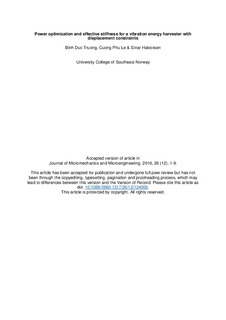Power optimization and effective stiffness for a vibration energy harvester with displacement constraints
Journal article, Peer reviewed
Accepted version
Permanent lenke
http://hdl.handle.net/11250/2563099Utgivelsesdato
2016Metadata
Vis full innførselSamlinger
- Institutt for mikrosystemer [546]
- Publikasjoner fra CRIStin [3623]
Originalversjon
Journal of Micromechanics and Microengineering. 2016, 26 (12), 1-8. 10.1088/0960-1317/26/12/124006Sammendrag
This paper presents experiments on how to approach the physical limits on power from vibration energy harvesting under displacement-constrained operation. A MEMS electrostatic vibration energy harvester with voltage-control of the system stiffness is used for this purpose. The power saturation problem, when the proof-mass displacement reaches a maximum amplitude for sufficient acceleration amplitude, is shifted to higher accelerations by use of load optimization. In addition, we demonstrate the effect of varying the electromechanical coupling k 2. Measurement results show that harvested power can also be made to follow the optimal power of the velocity-damped generator for a range of accelerations, which implies displacement constraints. Compared to the saturated power, the power increases 1.5 times with the optimal load for electromechanical coupling at k 2 = 8.7%. This is improved 2.3 times for a higher coupling of k2=17.9%. The obtained system effectiveness exceeds 60%. This work shows a first demonstration of reaching optimal power in the intermediate acceleration-range between the two extremes of maximum efficiency and maximum power transfer. The experimental results follow the theoretical results for a device with both load and stiffness tuning surprisingly well, despite only optimizing the load here. We compared a linearized lumped-model of the device with the same augmented by end-stop nonlinearities. The comparison shows that an effective stiffness due to end-stop impacts in the latter model closely matches the optimal stiffness for the former model, and therefore can explain why the experimental output power is close to optimal despite the lack of deliberate stiffness tuning.
